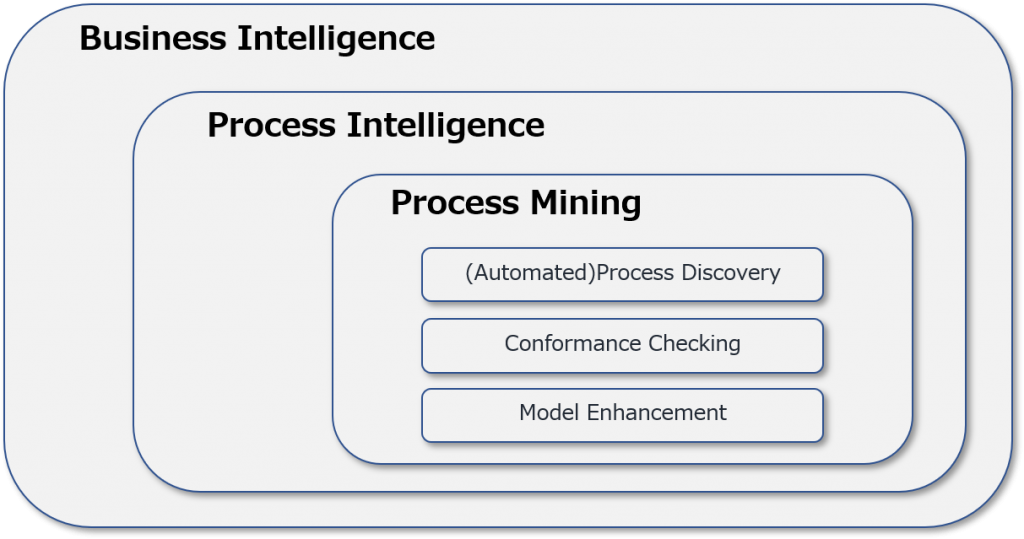Introduction to Process Mining (2) History of process mining
English follows Japanese. Before proofread.
プロセスマイニングは、2019年に20歳の誕生日を迎えたばかりの若いテクノロジーです。今回は、プロセスマイニングの歴史について簡単にご紹介します。
プロセスマイニングの生みの親は、”God Father of Process Mining”と呼ばれる、オランダ人のWil van der Aalst氏(RWTH Archen大学教授、以下Aalst氏)です。
コンピュータサイエンティストとして、世界的に著名な Aalst氏の主要専門分野は、情報システム(IT)、ワークフローマネジメント、プロセスマイニングであり、Archen大学では、Process and Data Scienceグループを率いています。
Aalst氏は1990年代後半、オランダのEindhoven University of Technology(TUe、以下TUe)においてワークフロー、ワークフローマネジメントを研究するなかで、現状の業務プロセスを把握するための既存の手法、すなわちインタビューやワークショップでは、主観的で断片的な情報に基づく不完全なプロセスモデルしか描けないことに問題を感じていました。
一方で、1990年代は、SAP社のERPを始めとする業務システムが普及しつつあり、企業・組織の様々な部門における業務の多くがITシステム上で行われれるようになっていました。
そこで、Aalst氏は、ITシステムに記録されている操作履歴、すなわちイベントログから、業務プロセスが再現可能ではないかというアイディアを着想しました。Aalst氏によれば、「プロセスマイニング」という言葉を初めて使用したのは、1998年に書いた研究計画書とのこと。
そして、Aalst氏はプロセスマイニングの研究に1999年から本格的に取り組み始めます。したがって、1999年がプロセスマイニングの誕生年であり、生誕の地はオランダ、ということになります。2000年代初頭からは、Aalst氏が在籍していたTUeを中心に学術研究が活発に行われてきました。
イベントログからプロセスモデルを再現するためのアルゴリズムとしては、まずは「アルファアルゴリズム」が用いられました。その後、より信頼性の高いプロセスモデルを表現するために、「ヒューリスティックマイナー」や「インダクティブマイナー」など、様々なアルゴリズムが開発されています。
2004年には、オープンソースのプロセスマイニングツール、「ProM」の最初のバージョンが開発されています。ProMは現在もバージョンアップを重ねており、主に大学での研究に用いられています。研究に用いられるだけあって、最先端のアルゴリズムや新たな機能がプラグインとして次々と提供されている点がProMの特徴です。
現在は存在していませんが、初めてのプロセスマイニングの会社、「Futura社」が2007年に設立されました。2010年前後からはプロセスマイニングを専門とする会社が次々と誕生しています。
具体的には、2009年にProcessGoldが設立されています。また、Aalst氏の下でプロセスマイニングを研究し、修士号を取得したAnne Rozinat氏は、卒業後、2010年にFluxiconを設立、プロセスマイニングツール、「Disco」を開発しています。2011年には、現在業界をリードするCeonisが誕生しています。
2010年以降、新たなプロセスマイニングツールが次々と市場に登場するなか、欧州においてプロセスマイニングの認知度・理解度を高めることに最も貢献したのは、Aalst氏以外には、「Process Mining Camp」という年次イベントを2012年から開催してきたFluxiconのAnne氏だと言えるでしょう。
Aalst氏は、2011年にプロセスマイニングに関する初めての著作『Process Mining: Data Science』(現在は2016年版)を出版、また2014年にはCouseraで当著作と同じタイトルのMOOC、すなわちeラーニングコースを開発、提供を開始しています。当eラーニングコースは、これまでに世界中で数万人が受講しており、プロセスマイニングの基本的な知識・ノウハウを広めることに寄与しています。
欧州においてプロセスマイニングが本格普及期に入ったのは、2015年ころからです。2018年以降はRPAに続く、大きな成長分野として注目が高まりました。2019年には、国際的なプロセスマイニングコンファレンス、「International Conference on Process Mining 2019」がドイツのArchenで初めて開催されました。2020年には、イタリアのPaudaで同コンファレンスが開催予定です。
欧州以外のエリアでは、ProMと同じオープンソースのプロセスマイニングツール「Apromore」が開発されたUniversity of melbourneの研究者を中心にオーストラリアでの取り組みが活発です。
米国、および日本ではともに、2019年からプロセスマイニングが本格的に紹介されはじめました。日本では、Impress社が主催した「プロセスマイニングコンファレンス2019」が2019年9月に開催され、約500人の参加者を集めて、関心の高さを示しました。
アジア全般ではまだまだ取り組みはこれからというところですが、韓国ではAalst氏の下で学んだ研究者が開発した「ProDiscovery」を有するPuzzle data社が、韓国企業でのプロセスマイニング導入実績を積み重ねています。
日本の場合、現在市場での存在感が大きいのは、CelonisとmyInvenioの2つのツールに限られますが、今後様々なプロセスマイニングツールが日本に紹介され市場が拡大していくことは間違いないと思われます。
Process mining is a young technology that
just turned 20 in 2019. Here’s a brief history of process mining.
The creator of process mining is Dutch researcher, Wil van der Aalst, Professor, RWTH Archen University, being called as “God Father of Process Mining”.
As a computer scientist, world-renowned Aalst’s key areas of expertise include information systems, workflow management and process mining, and at Archen University, leads the Process and Data Science Group.
In the late 1990s, while studying workflow
and workflow management at Eindhoven University of Technology (TUe) in the
Netherlands, Aalst was challenged by the fact that existing methods for
understanding current business processes — interviews and workshops — could
only draw incomplete process models based on subjective and fragmented
information.
On the other hand, in the 1990s, business systems such as SAP ’ s ERP became widespread, and many of the business operations in various departments of companies and organizations were conducted on IT systems.
So Prof. Aalst came up with the idea that
business processes could be replicated from the operational history, or event
log, recorded in IT systems. According to Aalst, the term “process
mining” was first used in a research proposal he wrote in 1998.
Aalst began working on process mining in
earnest in 1999. Therefore, 1999 is the year of the birth of process mining,
and Holland is the birthplace of process mining. Since the early 2000s,
academic research has been actively carried out by TUe and other European universities.
The first algorithm used to reconstruct the process model from the event log was “Alpha Algorithm”. Since then, various algorithms such as “Heuristic Miner” and “Inductive Miner” have been developed to represent more reliable process models.
In 2004, the first version of
“ProM” an open source process mining tool, was developed. ProM is
still being upgraded and is mainly used for research. ProM is unique in that it
is used for research, and the latest algorithms and new functions are provided
as plug-ins one after another.
The first process mining company that no
longer exists, “Futura” was founded in 2007. Since around 2010,
companies specializing in process mining have emerged one after another.
ProcessGold, which has been acquired by UiPath in October 2019, was established in 2009. After graduating, Anne Rozinat, who studied process mining under Aalst and received a master’s degree, founded Fluxicon in 2010 to develop a process mining tool called “Disco”. In 2011, the current industry leader, Ceonis, was born.
With new process mining tools on the market since 2010, it’s Anne of Fluxicon who’s done the most to raise awareness and understanding of process mining in Europe by holding “Process Mining Camp” every year since 2012 besides Prof. Aalst.
Aalst published his first work on process mining in 2011, ‘Process Mining: Data Science in Action’ (The current version is 2016.), and in 2014 developed and began offering MOOC with the same title of the book, an e-learning course, at Cousera. Tens of thousands of people around the world have taken this e-learning course, helping to spread the basic knowledge and know-how of process mining.
In Europe, process mining started becoming
widely used around 2015. Since 2018, it has gained attention as a major growth
area following RPA. In 2019, the first international Process Mining Conference,
“International Conference on Process Mining 2019” was held in Archen,
Germany. In 2020, the conference will be held in Pauda, Italy.
Outside of Europe, Australian practice is centered around researchers at the University of Merlbourne, which developed the open source process mining tool “Apromore”.
Process mining has been practically introduced in both the U.S. and Japan since 2019. In Japan, the “Process Mining Conference 2019” hosted by Impress attracted 500 participants and showed great interest.
In Korea, Puzzle data, which has a
“ProDiscovery” developed by a researcher who studied under Aalst, has
a track record of introducing process mining in Korean companies.
In the case of Japan, although the two
tools Celonis and myInvenio have a strong presence in the market at present, it
is certain that various process mining tools will be introduced to Japan and
the market will expand.




































